
How to Make Money on YouTube Through Ecommerce
With 300 hours of video being uploaded to the website per minute and 3.25 billion hours of video content being consumed each month (Source), YouTube is currently the 2nd largest search engine and the largest video site in existence.
The website boasts an impressive one billion users, which is just about over one-third of the entire population of internet users, yet only 9% of small business owners in the US are known to use YouTube as a marketing tool.
As an online business owner, YouTube may be one of the most underrated yet efficient marketing tools at your disposal which you are most likely ignoring.
Let’s take a look at your current online marketing strategy: You have a product or service that you have worked incredibly hard to perfect and have painstakingly set up your ecommerce website. You know that you can most certainly capitalize on social media to grow your business, so you go on to create the corresponding social media pages/accounts on Facebook, Twitter, Instagram, etc. You are creating great content and have amassed a decent following through the various social channels, however, you feel that your business is not getting the exposure that it deserves. This is where YouTube steps in to step up your online marketing game.
There are several reasons why video content receives better audience engagement than other mediums:
- Video engages through non-verbal cues and communication
- It incorporates all other mediums: audio, text and visual
- The content presented is rich and able to convey the message in the fastest way possible
- It’s more compelling than any other medium
If none of these reasons seem good enough, here’s one that will definitely grab your attention: Videos rank you and your business better in search engine results. Since YouTube is owned by Google, videos that are uploaded on YouTube rank better in search engine results and even more so if the video and the accompanying information are both keyword-rich.
Besides, you can manipulate video content to best showcase your brand’s personality. You can get as creative as you want and, contrary to popular belief, great video content can be made on a small budget. It’s all about your vision!
A positive user experience with video content is said to increase a user’s brand association by 139% and increase their purchase intent by 97%.
Now, those definitely seem like impressive statistics.
This comprehensive guide will cover every aspect of how to make money on YouTube for your ecommerce store from setting up a channel that is best optimized for marketing your online business, understanding your demographics, creating the right content for your target audience, and finally, being able to cash in on the content you create and circulating it through various different methods, which we will look at in-depth.
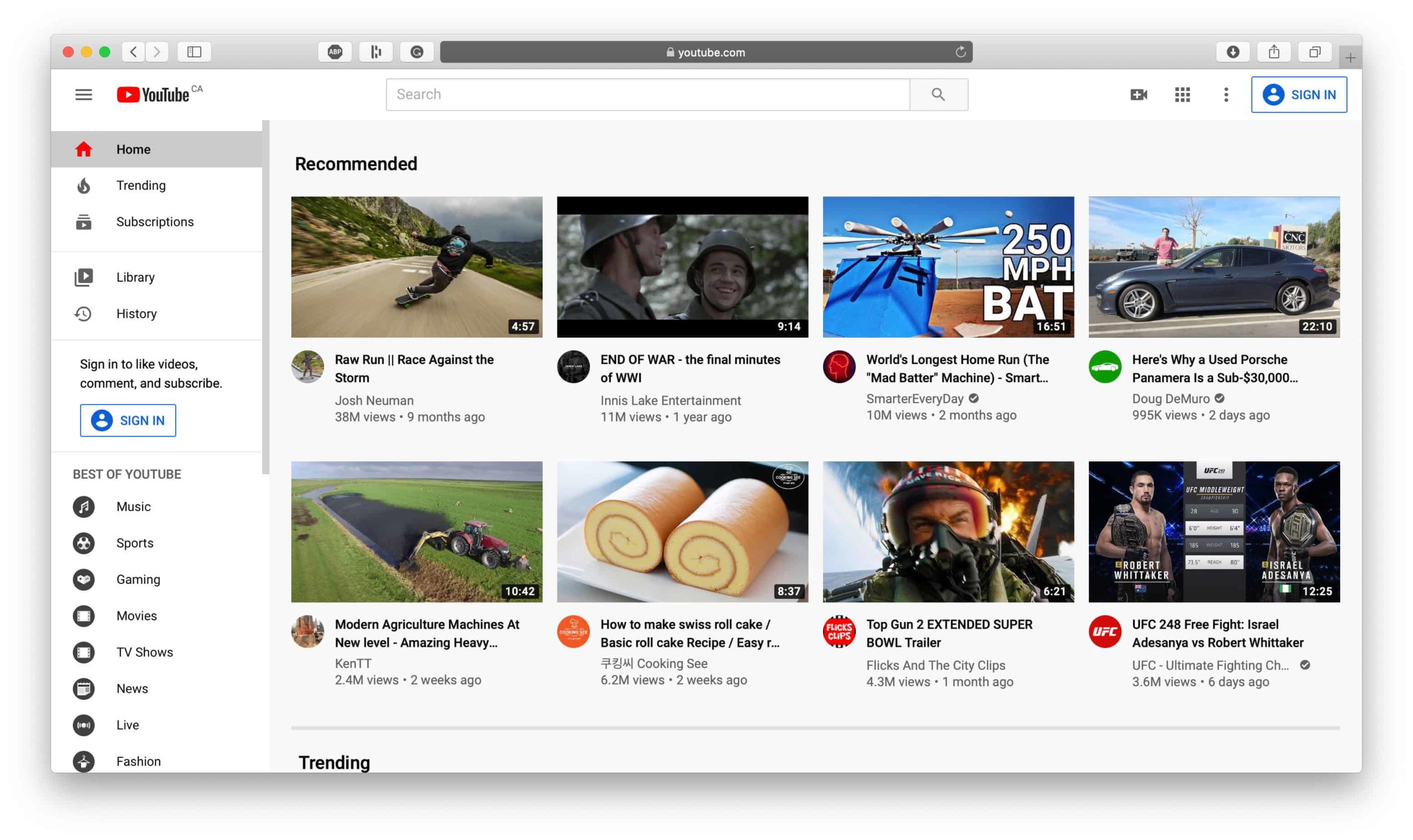
Customizing Your YouTube Channel for Your Online Business
The best way to go about setting up a YouTube channel for your business is to approach it as a tool in a marketing campaign, which is what it essentially is. This means that your channel should instantly make the user relate your brand/business with it. When the brand name is similar or close to the one on your channel, the user will register this as a legitimate and identifiable source, which is the first step towards improving your credibility and presence online.
The aesthetics and appeal of your channel, apart from the content you produce, is what will get new visitors to stay and old ones to return. Use the features provided by YouTube to the maximum, as they are there for a reason. Make sure you clearly outline what your channel is about and provide links to your online business and links to any other possible content that you have shared elsewhere, perhaps on other social media platforms. This helps create a net of all your online content for the user, with YouTube being a central point that holds all the links and important information.
Instead of just relying on the description box of your channel to let visitors know what your business is about, you should ideally create an introductory video of your business with an overview of the products and services that you have to offer. This is a great way to get your audience engaged with your channel right off the bat. The success of YouTube as a marketing tool heavily relies on the viewership, therefore if you are able to connect with the audience and attract people through your content, the number of views you get will steadily increase. Giving a glimpse of what your brand is all about is a surefire way of doing exactly that. Think of it as a trailer to a movie!
Things that your introductory video should ideally include:
- A Little Bit About Yourself: Your name, where you’re from, qualifications, etc.
- Information About Your Business: What do you do? Where are you based?
- Include a Call-to-Action in Your Intro Video: “Subscribe to the channel for great tips on…”, “Let’s get to know each other! Like and comment on the video to let me know where you’re from!…”
Create a content plan for your channel. What kind of videos do you want to make? Will they be more of the “How to…” type of tutorial videos? Are you leaning towards creating ‘Question and Answer’ style interview videos? Do you want to do a mix of both? Thinking about this helps give you a clear direction and create relevant content which helps save a lot of time.
Your content plan should be based on the following variables :
- Do Your Audience Research: What do they want to see? What are they coming to your channel for?
- How Often Will You Be Able to Post Content: Create a schedule and stick to it. Remember, out of sight is truly out of mind when it comes to content and consumers.
- Your Image: What image do you want to present of your brand, to your audience?
Another great way of optimizing your channel for your business is by posting something along the lines of a ‘Testimonial’ video. It’s a useful way to show new customers the reviews your product or service is getting. This, along with your introductory video, helps customers put a face to your brand and instill a certain amount of faith in your product/service.
Understanding Your Demographics & Utilizing YouTube Analytics
Like any great marketing campaign, it is essential to know what your niche audience and demographics are like along with the expected ROI (return on investment). The best way to know such information is to have an analytics report that quantifies the input versus the output achieved. But why is this important, you may ask? Simply put, as a business person you want to know how the content you are creating is impacting your business—are people even watching videos on your channel? Are they liking it? Who is watching? Is there any impact after watching (in regards to sales & revenue)? If such aspects are unclear or have negative responses, it’s important to know where you can improve and where else your resources may be better used. Take a step back, fine-tune your strategy and implement it again. But to do so, you need insight and that is where YouTube Analytics steps in.
Goal setting is an important part of using analytics in the right way. Ask yourself this question: What exactly is the expected end result? This will help you ascertain the most important metrics for you and your brand. For example:
- Is raising awareness for your brand your main goal? Use likes and shares to measure impact.
- Is your main goal to increase sales? Use the number of click-throughs from your videos to your website to measure impact.
Once you know what you are looking for and have a clear goal set, use YouTube and Google Analytics to obtain all necessary metrics for setting a powerful strategy. Each individual analytic tool can help you have a comprehensive understanding of the impact of your content.
YouTube Analytics Key Tools: Demographics, Source of Traffic & Location of Playback
- Demographics: Every video you upload will have an “Analytics” option under it. Clicking on this option gives you access to very specific details pertaining to the age, gender, and location of your viewers, specific to that particular video, thus giving you insight on whether you are reaching your target audience.
- Source of Traffic: When you know the primary source that your audience uses to find your video content, you can use that data to show the efficiency of your current marketing strategy and work on new ways of bringing in traffic. This tool in the YouTube Analytics arsenal will provide you with data on where your viewers are coming from: social media channels, search engines or other websites. You will have a list of sources with accompanying numbers for each source and also how long they stayed on your channel and watched your videos.
- Location of Playback: The playback location tool tracks videos that are possibly embedded on other websites, blogs and media bases, or even perhaps shared on a particular social media channel. This gives you insight into which medium works best for your content.
Google Analytics Key Tools: Social Reports & Referrals
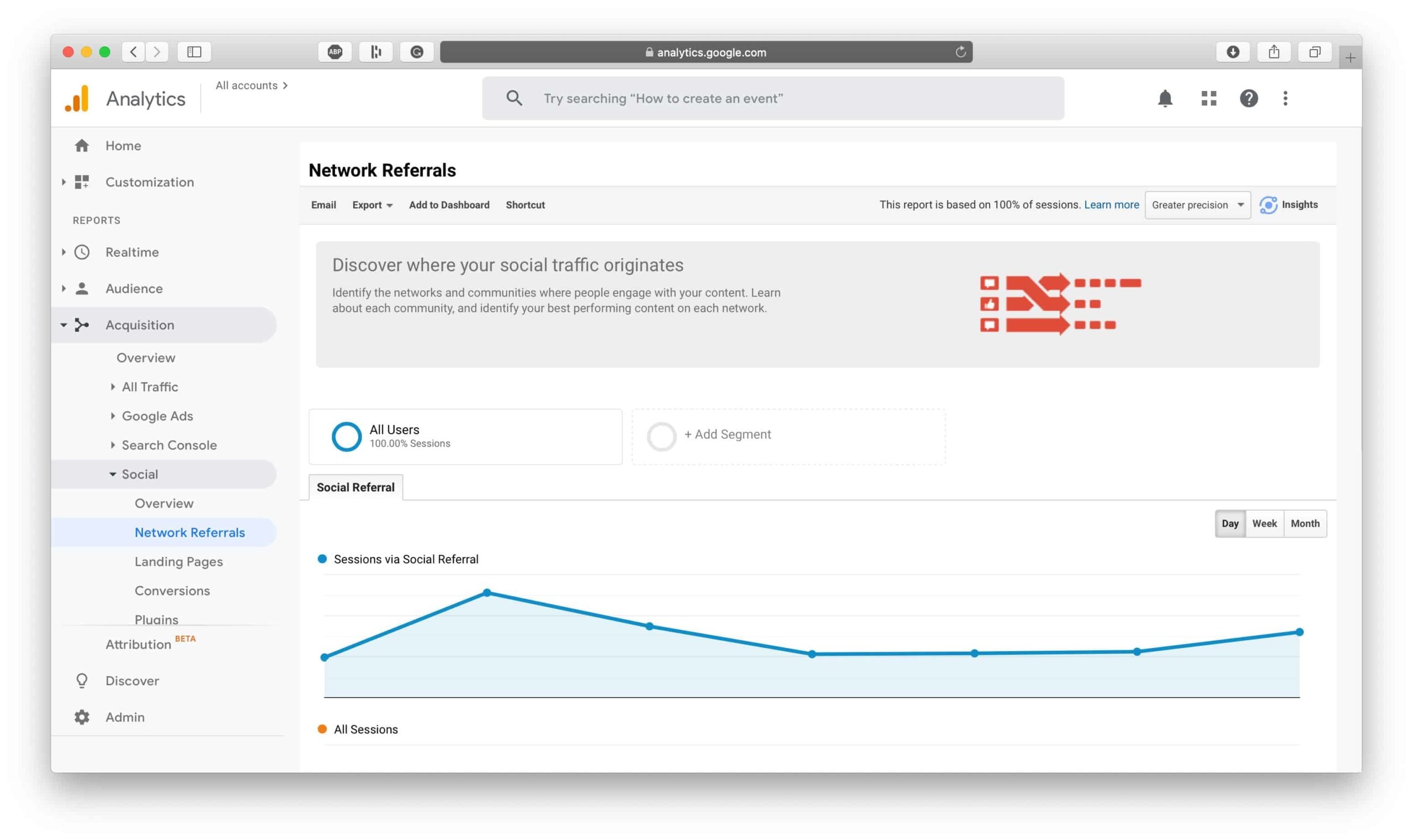
- Social Reports: This is a basic comparison tool that shows how YouTube is doing against other social media channels. It’s important to remember that it’s not just about the quantity of engagement here but also the quality, as YouTube may show lower engagement but the sessions through this channel may be longer due to more engaged visitors.
- Referrals: Just having information about the audience is not enough. YouTube Analytics will give you metrics on overall audience engagement and viewership, however, it’s the Google Analytics Referrals tool that will give you in-depth data beyond the videos; namely, customer conversions. It’s not just enough to know whether the user is just viewing your content and clicking on the link to your website, but also whether they sign up for your monthly newsletter, engage with more of your content and actually convert into customers. A referral report comes in handy when you want to analyze engagement data such as the bounce rate, sessions and the average duration of the sessions. This data will allow you to draw a clear picture of the quality of traffic that you are most likely receiving and give you a better idea as to whether your YouTube marketing strategy is really working for your business. It’s simple: if a viewer stays on your website longer they’re more likely to be converted into a customer.
Using YouTube and Google Analytics to collect and study data for your business is an effective way to know whether you are achieving the expected results and reaching your target goals. If you are, well brilliant! If you aren’t, you’ll know exactly what aspect you need to work on to make your online marketing strategy more effective.
What Kind of Content Works Best?
The two factors that can lead to making compelling video content are great storytelling that reflects your brand’s identity and a high entertainment quotient.
Think about it: If you were a customer looking to purchase a product or service online, which of these two options would lead you to actually buy it:
- Static images and text on a video—something like a PowerPoint presentation,
- Or showcasing a fluid storyline, involving people who improve their work or personal lifestyle because of the product?
The reason the second option works is because it makes the video more convincing by showcasing your product or service live, while conveying your brand’s image and beliefs a more extensive and life-like way. Even most big brands like Apple and Google invest heavily in creating aesthetically appealing video content with the core focus being on the users and how they will incorporate specific products into their lives seamlessly and for the better.
Another way to bring value and views to your video content on YouTube is by having an entertainment quotient in it. Creating entertaining videos for your YouTube channel that cater specifically to your target audience’s interests is a surefire way to get and retain their attention and draw them to your product.
Several major YouTube channels, including some that belong to ecommerce stores, use YouTube as a tool for marketing and have managed to build an extremely impressive audience base that continuously grows by creating highly engaging content that is targeted at their demographic. The mantra here is basically, “Give ‘em what they want!”. It doesn’t have to be everyone’s cup of tea, but if the content you are creating is resonating with your target audience, you are definitely on the right track and the payoff can be tremendous!
The introductory & testimonial videos may be a great way to start off, but then what? There’s no point in having a channel if there isn’t any content on it, or if the content gets repetitive. Would you like to see the exact same content week after week, as a consumer? Probably not.
As mentioned previously, planning a content strategy is the best approach. When it comes to YouTube marketing, you need to remember that it is a long term commitment and thus involves a lot of planning. Set a schedule, perhaps weekly, fortnightly or monthly, but stick to it so that your audience is aware of when new content will be available. User engagement is everything, so when planning keep that in mind. Keep it simple, yet get creative. You don’t necessarily have to give off a “Buy my product!” vibe in every video, even though you are using YouTube to improve sales. The point is to show how great your product is and how it will improve and enhance the buyer’s lifestyle without preaching to them to make the purchase. Let them come to that conclusion on their own.
An ecommerce company that has had huge success on YouTube and currently has over 3 million subscribers is Luxy Hair. This company was started by husband-wife duo Alex and Mimi Ikonn, along with Mimi’s sister Leyla, and they sell high quality, 100% Remy Human Hair clip-in hair extensions online at competitive prices. They have managed to turn YouTube into a marketing platform as the majority of their customers were introduced to their website through their channel. They haven’t, however, just used YouTube to show off their products and tell their audience to buy them, they’ve approached it in an entirely different way: subtle advertising.
They have a beautifully designed channel on YouTube, that uses the website’s features to the best of its capabilities:
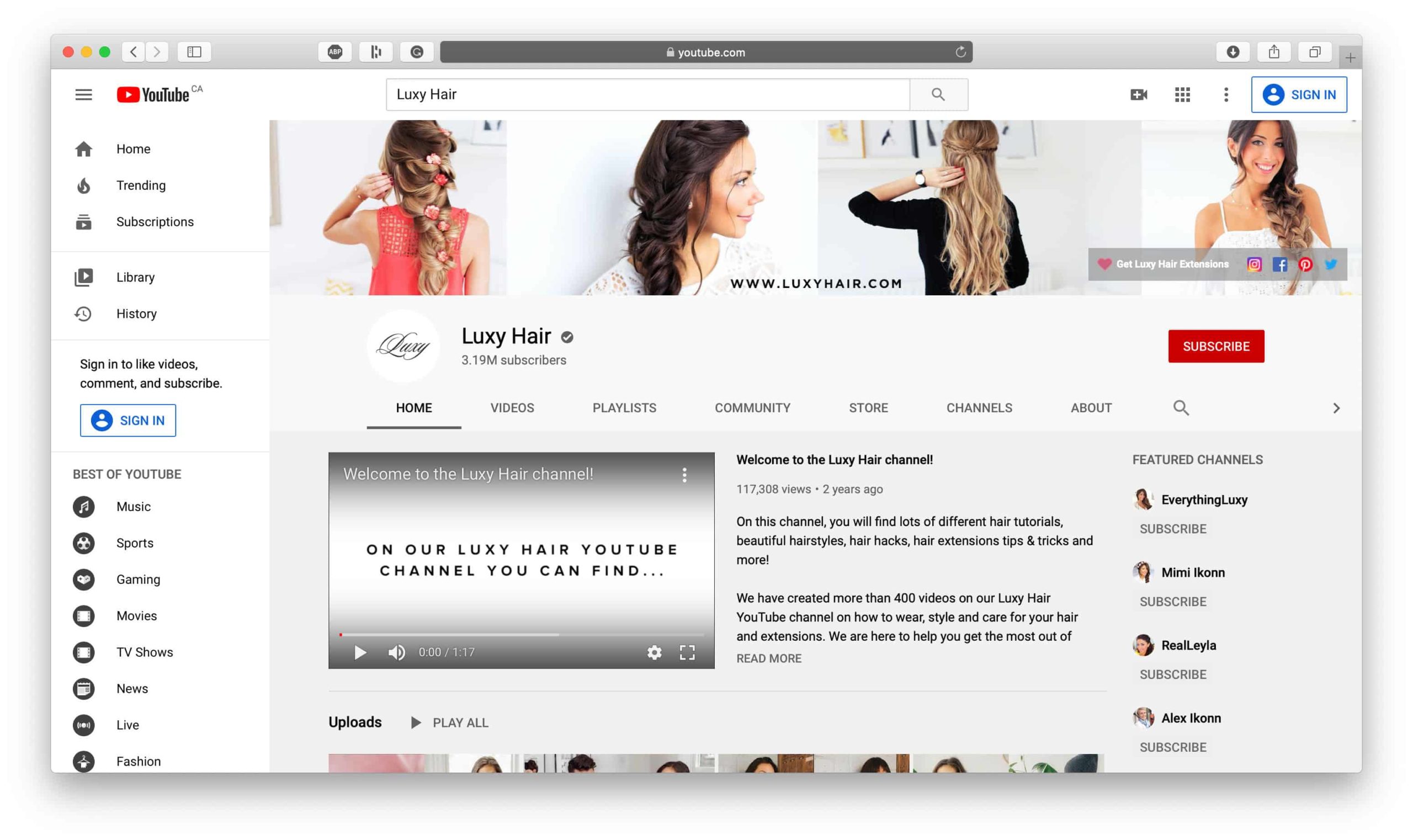
Note how the home tab has an introductory video, an appealing banner, links to their social media handles, other featured channels and a brief but well-written description.
Instead of actively promoting their product, which can get monotonous for the viewers, they create a variety of videos such as “How to: Hair and Beauty Tutorials,” “Hair-Hacks,” “Tips and Tricks,” etc. and they always link to their website in the description box of the video as well as include links to where viewers can directly purchase the products. Since the start of their channel, they’ve received over 400 million views and have grown an audience of engaged individuals by providing free content that shows how to use their product in a variety of ways.
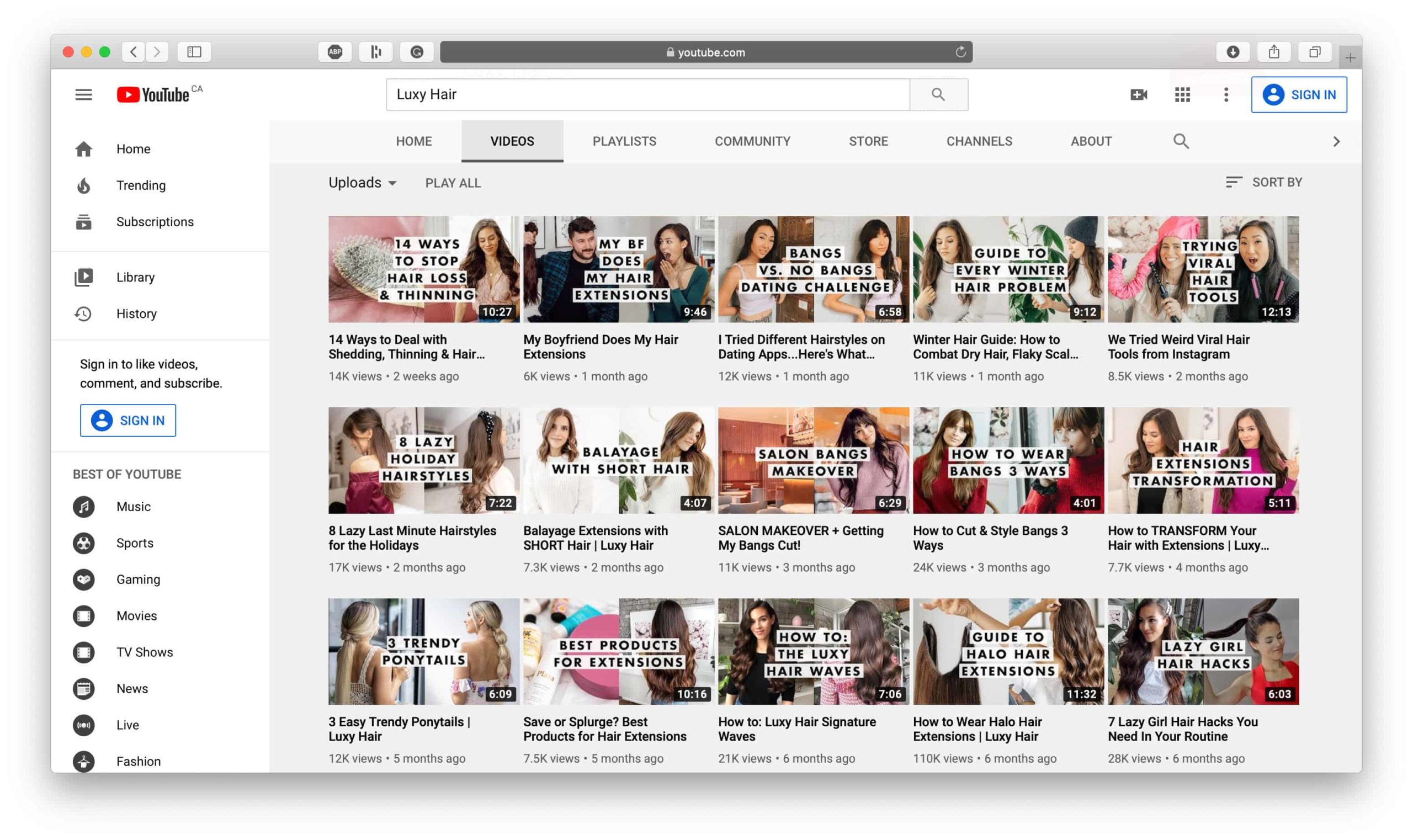
The style of the content you create will probably vary until you find your niche, but it can be exciting to experiment and figure out what works best for your channel and your business based on engagement and views. Once you realize the true potential of YouTube as the great marketing tool that it is and actually start to make money off it, your motivation to create great content is likely to increase. This won’t happen overnight of course, but the long term pay off is possible.
Optimizing Your Videos for Search
Even though you may be creating awesome content and using rich keywords, there is a lot more you could be doing to make sure that your content ranks well. Due to the high volume of content constantly being uploaded to YouTube every second, it is imperative to stay at the top of your SEO game so that your content doesn’t drown in such a saturated environment.
Every single aspect of the videos you post on YouTube, from the content itself to the way you frame the accompanying title and description to the kind of tags and keywords you use, have a direct impact on how your videos rank in search engines.
Here are a few ways to help boost your ranking, get views, and engage your audience:
Keywords
In order to effectively optimize your videos, it is essential to make a note of the particular keywords that you will be focusing on.
Make a list of words that you might search for if you were to look for the exact content you’re posting and several other related words. Now cross-check your list with keyword tools that are available online for free, we recommend KWFinder, to make sure that they rank well in popularity as search terms. Not only does this ensure that you use relevant tags and keywords, but it can also be a reference point for ideas for future content as this will give you an understanding of what people are looking for in relation to your content or even your industry.
Engagement
The entire point of using YouTube for marketing purposes is to generate audience engagement and, in order to rank your video in search engines, YouTube will use engagement as a reference point to determine quality. So, needless to say, engagement is pretty important.
The more users that actually comment, subscribe to your channel, favorite your videos, or like the content after viewing it, the higher the chance of your video ranking better in search results as it reflects that the audience is actively engaging in a dialogue with you. Therefore, using call-to-actions such as “If you’re new to my channel please subscribe,” or “If you liked this video please give it a thumbs up,” during each video is essential.
Other than that, frequently asking your audience for their input or opinions and holding giveaways or contests often are also surefire ways to get your audience to engage with your videos.
The view count of your videos also plays a factor in engagement, so don’t forget to promote your video through various social channels, on your website, online forums such as Reddit (try /r/NewTubers or /r/SmallYTChannel) and even word-of-mouth to help boost your views.
Format
Pay close attention to the kind of videos you are posting and what you are posting along with it. As mentioned above, any text that is keyword-rich will rank higher in search engines, so make sure that your video’s title and description box utilize appropriate keywords.
- The description box should include all relevant information discussed in the video such as links to mentioned resources, products, social media channels, your website, etc.
- When tagging the video, make sure that you choose quality tags over quantity, so only use tags that are keywords you’re targeting or ones that have direct relevance to the video’s content.
- Ensure that your videos are long enough to cover the topic succinctly without being too short or going too off-topic. YouTube values content that gives the audience what they’re looking for without wasting their time, so create your videos accordingly. Remember to edit out any aspects of the footage that don’t add to the main theme of the video.
Monetizing Your YouTube Content
Now that you have your channel set up, content planned out and everything optimized so as to have high engagement levels and viewership, what’s next? Cashing in on your content, of course! Apart from using YouTube as just an online marketing tool, there are other options to successfully make money through it. Every option will be subjective to your business, so use your discretion as to what works for you and what doesn’t.
Here are the ways you can monetize your channel:
Ad Programs
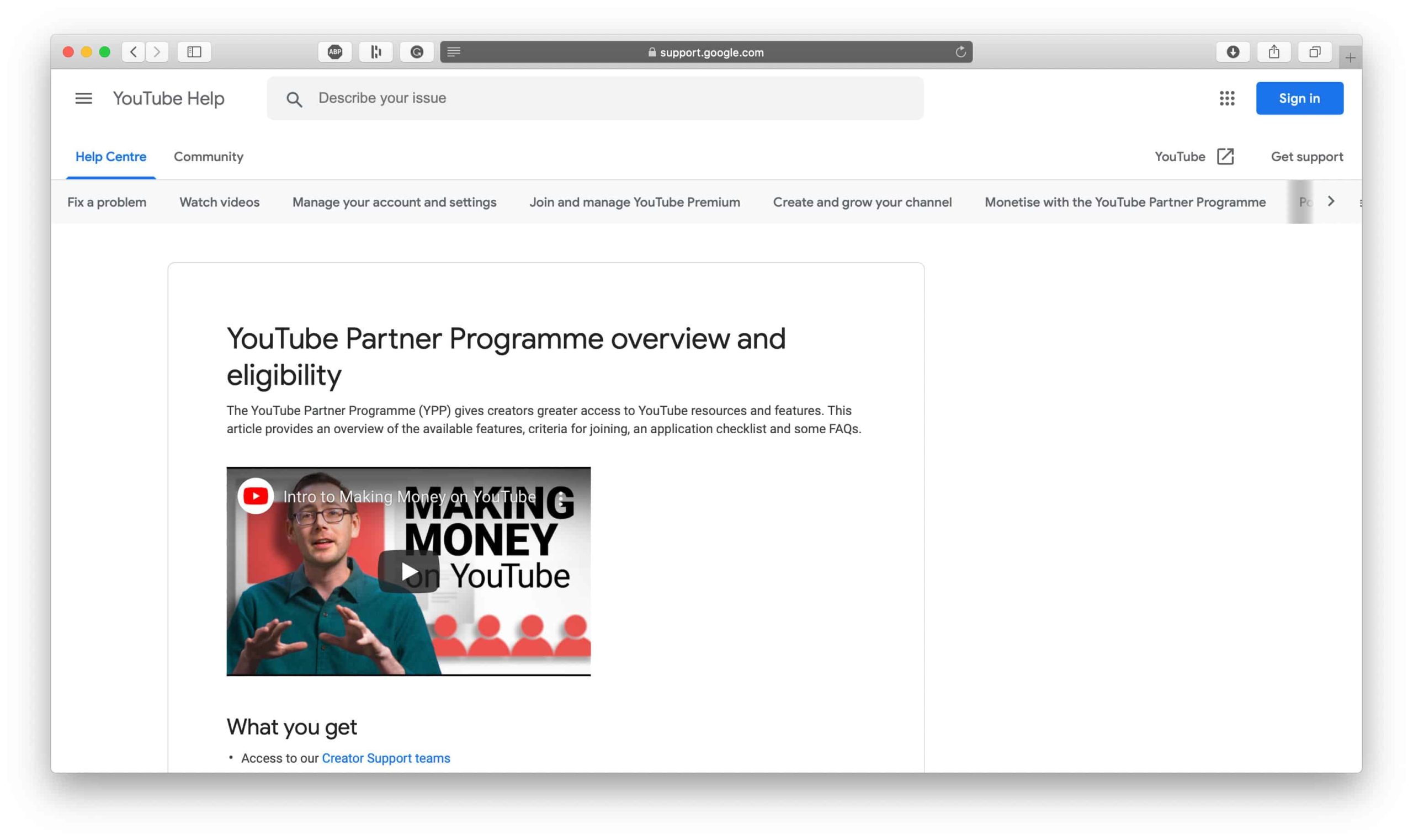
One of the most common ways of monetizing your YouTube channel is through ads. In order to do so, you will be required to register yourself as a YouTube Partner, which can be done in the “Creator Studio” part of your channel. To be able to monetize your channel, you have to meet certain criteria.
The next step after registering yourself as a partner is to set up a Google AdSense account which will give you admission into Google’s Ad Network and enable you to get paid and check revenue reports whenever you need to. When this step is successfully complete, you will be able to see a dollar sign “$” in green next to videos in the video manager section of your channel which typically tells you whether that particular content is authorized for monetization.
Viewers who actually view entire ads, or at least up to 30 seconds, are said to be at least 23 times more likely to engage with the brand’s channel through subscribing to it, watching more of their content and even sharing the brand’s videos. Even viewers who don’t watch the ads to completion are still 10 times more likely to engage with the brand. There can even be an exponential increase of up to 500% in the viewership of existing content when ads are used in conjunction with new videos.
However, there are several things that you should keep in mind when using an ad program, especially Google AdSense, to make money on your channel. Ads may not be valid on your videos due to several reasons established by YouTube, in order to censor out content from their ad program that may not be “advertising-friendly”.
According to the official guidelines listed on their website, here are some of the reasons that ads may be excluded from your videos:
- Controversial Issues & Sensitive Events: Sexual content or abuse, extremism & graphic imagery in your content.
- Drugs & Dangerous Products or Substances: Content that promotes or features the sale, use, or abuse of illegal drugs, regulated drugs or substances, or other dangerous products are not eligible for advertising. Any drug or related product can’t be glorified either.
- Harmful or Dangerous Acts: Any content that promotes dangerous or harmful behavior.
- Hateful Content: Content that propagates discrimination or humiliation of an individual or group based on different factors such as age, gender, sexuality, race, etc.
- Inappropriate Language: Content that repeatedly presents strong profanity or vulgarity.
- Inappropriate Use of Family Entertainment Characters: Video content that portrays family entertainment characters, whether animated or live-action, that are actively engaged in inappropriate behavior, even if done for comedic purposes.
- Incendiary & Demeaning: Content that may be insulting and/or demeaning to an individual or group.
- Sexually Suggestive Content: Highly sexual content/pornography.
- Violence: Content where the focal point is on blood, gore, violence, or injury when presented without any other additional context.
You can find the entire detailed outline here on the Google Support website.
Even though ad programs may be one of the more accessible ways to monetize your channel, it would be unwise to just stick to this method. Not only does YouTube keep almost 50% of the ad profits, but it’s always sensible to have other methods of sustaining cash flow at the same time.
Affiliate Programs
Youtube channels that review products, whether directly or indirectly, have another common way to monetize their channel: affiliate marketing. Other types of video content can of course still implement affiliates, but review videos tend to be the most natural fit.
There are several different affiliate programs out there, some of the more popular ones being the Amazon Associates Program and Shopify Affiliate Program. Affiliate marketing is possibly the fastest and most convenient way to make some extra money through Youtube while also boosting traffic to the affiliated website. All you have to do is register yourself with an affiliate program and place the affiliate link to the products you mention in the video in the description box. When a viewer purchases a product through your affiliate link you get a commission of the sale. If you choose to use affiliate links make sure to conduct your own due diligence that you’re working with reputable affiliate programs and that you’re disclosing affiliate links appropriately to your audience (this will depend on the laws and regulations where you’re from or located).
Regular Promotion Through Social Media
Don’t forget that sometimes the most effective way of growing your business’ credibility, and in turn, your profits, is simply through promoting your content on social media. When you share video content from YouTube on your other social channels such as Facebook or Twitter, they are embedded links which means that each view counts towards audience engagement in your analytics, too.
Furthermore, if any of your friends or followers on social platforms share your YouTube videos, they act as referrals which are likely to be promoting your content to other people who are a part of your target market. Referrals are a powerful marketing tactic because when others share your content they’re basically vouching for you to their friends and followers and suggesting that they also check out your content. Your videos don’t have to go viral, just give them the opportunity to be shared amongst other relevant audiences that have the potential to be converted to customers.
Sponsorships & Influencer Marketing
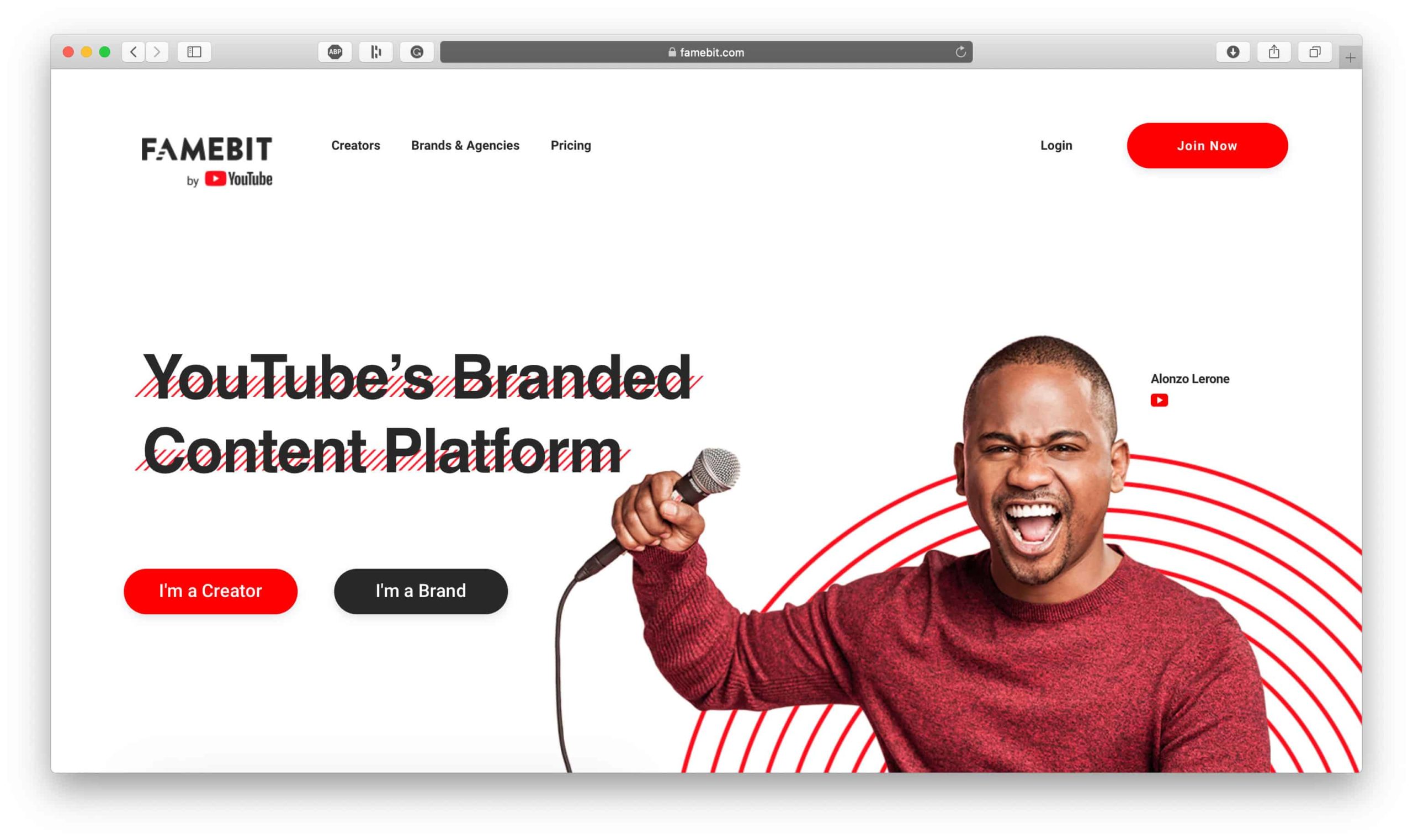
This method of cashing in on your YouTube channel may not involve directly cashing in on content, however, it can be beneficial to help you make profits, which is what the ultimate goal is. Sponsorship and influencer marketing work in two ways:
- You act as the influencer or sponsor to advertise someone else’s business on your channel
- You use another influencer or sponsor to promote your business on their channel
With the first option, you need to establish your channel as a credible and popular source first. Like many Youtube influencers out there, once you start amassing a sizeable following you’ll likely start getting endorsement offers, promotional projects from brands, complementary products and services, and you’ll even have the leverage to reach out to brands to work out a promotion deal on your own behalf. It may seem like this is not effective to your overall business strategy because, after all, why would you want to promote another business?
This is a great way to establish contacts and create a network within your industry through Youtube. It’ll give you an insider’s perspective and the advantage of knowing what’s hot in the market, who your competitors are and which products and services best complement yours. When deciding which brands to work with, consider these factors:
- Does the other brand’s product/service complement yours?
- If so, is there any conflict of interest? Will promoting their brand take away from your business or add value?
- Does their brand persona, personality and beliefs align with yours?
- Will their product or service be a natural fit for you as an influencer? This could be in terms of the kind of content you produce, your channel theme, etc.
- Is their product/service a good fit for your audience? Does it align with their interests and beliefs?
It’s important to understand that even though promoting and earning from another brand may seem lucrative, it could also have adverse effects on your business if you choose to collaborate with the wrong kind of brands. When you do find a natural fit it will result in better sentiments from your viewers towards both you and the brands you work with.
Similarly, when you sponsor another influencer to promote your business it should add value to your brand and be a purposeful and mutually beneficial move. Make sure you approach influencers that have an engaged and loyal audience that fits your business’ target market. Don’t forget to assess your budget before you reach out to influencers, though. Most Youtube influencers have a flat fee for sponsorships and demand about 5-15 cents/view depending on their audience engagement. Some may even argue for a higher fee, but most sponsorships can be negotiated, within reason.
Whether you are promoting a brand or asking someone else to promote yours, transparency is key. Being upfront with your viewers about why you’ve accepted a paid partnership or why you’re sponsoring a paid partnership will go a long way to establish trust between you and your audience, so be honest with them. Educate yourself on the laws for disclosing paid partnerships where you’re located as there could be very specific rules and regulations around how you can and cannot disclose which videos include sponsored content.
There are several online marketplaces that you can list yourself as an influencer on or use to find influencers to work with. There’s usually some sort of criteria to join, so ensure that you meet their standards. A few such websites are:
List yourself in as many places as you can to maximize your visibility and improve your chances of landing great offers.
Conclusion
According to recent statistics provided by Youtube itself, the number of channels that earn six figures annually on the platform has increased by over 50% year over year.
Through strategically planned online marketing campaigns, engaging content and motivation to achieve long term goals that are aligned with your business goals, even a small YouTube channel can turn into a profitable and effective marketing channel. As mentioned previously, the number of subscribers and video views are not the only factors determining your profit potential, but also how engaged your audience is and the niche you are catering to.
If you are an online business owner who is still trying to decide if online video marketing is the way to go, the statistics, tips, and guidance in this article should definitely help you decide whether it’s worthwhile for your business.



